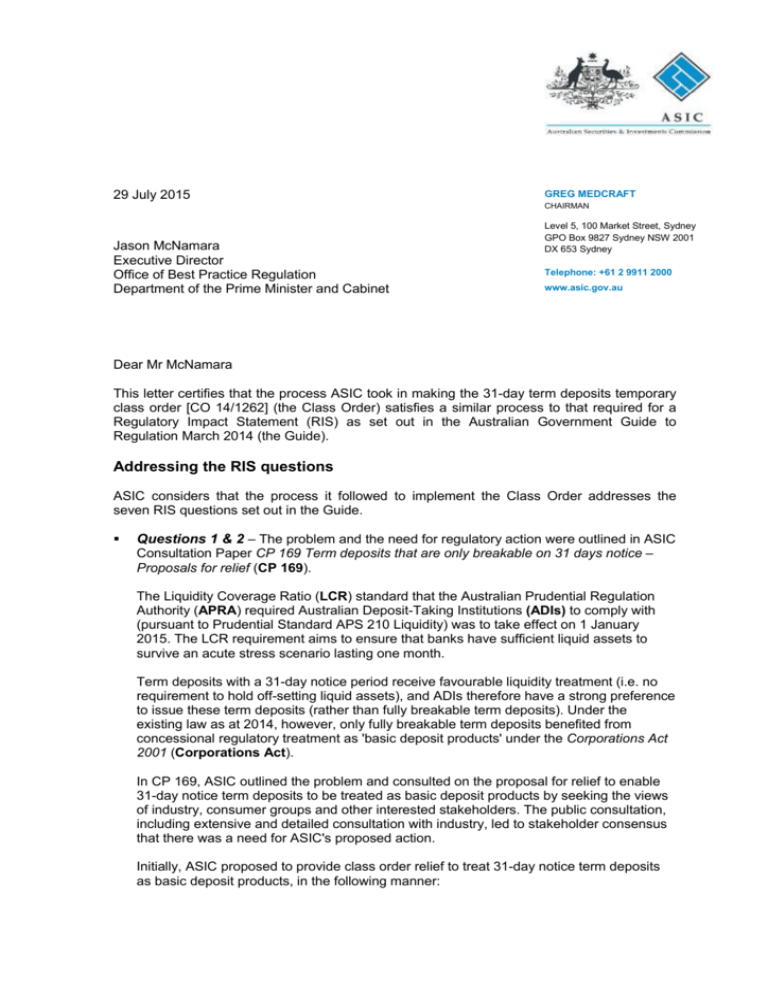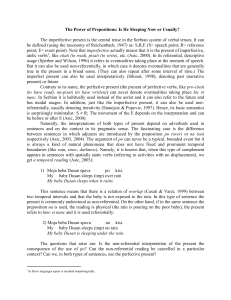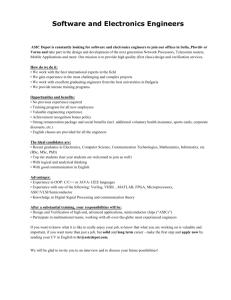GREG MEDCRAFT chairman Level 5, 100 Market Street, Sydney
advertisement

29 July 2015 GREG MEDCRAFT CHAIRMAN Jason McNamara Executive Director Office of Best Practice Regulation Department of the Prime Minister and Cabinet Level 5, 100 Market Street, Sydney GPO Box 9827 Sydney NSW 2001 DX 653 Sydney Telephone: +61 2 9911 2000 www.asic.gov.au Dear Mr McNamara This letter certifies that the process ASIC took in making the 31-day term deposits temporary class order [CO 14/1262] (the Class Order) satisfies a similar process to that required for a Regulatory Impact Statement (RIS) as set out in the Australian Government Guide to Regulation March 2014 (the Guide). Addressing the RIS questions ASIC considers that the process it followed to implement the Class Order addresses the seven RIS questions set out in the Guide. Questions 1 & 2 – The problem and the need for regulatory action were outlined in ASIC Consultation Paper CP 169 Term deposits that are only breakable on 31 days notice – Proposals for relief (CP 169). The Liquidity Coverage Ratio (LCR) standard that the Australian Prudential Regulation Authority (APRA) required Australian Deposit-Taking Institutions (ADIs) to comply with (pursuant to Prudential Standard APS 210 Liquidity) was to take effect on 1 January 2015. The LCR requirement aims to ensure that banks have sufficient liquid assets to survive an acute stress scenario lasting one month. Term deposits with a 31-day notice period receive favourable liquidity treatment (i.e. no requirement to hold off-setting liquid assets), and ADIs therefore have a strong preference to issue these term deposits (rather than fully breakable term deposits). Under the existing law as at 2014, however, only fully breakable term deposits benefited from concessional regulatory treatment as 'basic deposit products' under the Corporations Act 2001 (Corporations Act). In CP 169, ASIC outlined the problem and consulted on the proposal for relief to enable 31-day notice term deposits to be treated as basic deposit products by seeking the views of industry, consumer groups and other interested stakeholders. The public consultation, including extensive and detailed consultation with industry, led to stakeholder consensus that there was a need for ASIC's proposed action. Initially, ASIC proposed to provide class order relief to treat 31-day notice term deposits as basic deposit products, in the following manner: 2 permanent relief for term deposits of up to two years; and temporary relief of two years for term deposits of between two and five years. In April 2014, the Government indicated it intended to amend the definition of 'basic deposit product' in the Corporations Act, to enable unbreakable term deposits (for terms of up to two years) and 31-day notice term deposits (for terms of between two and five years) to be classified as basic deposit products. The reforms were to be introduced into the Spring sitting of Parliament in 2014. As a result, ASIC issued a no-action letter for the Australian Bankers' Association (ABA) to distribute to its members (rather than a class order) in June 2014. This provided a short term 'safe harbour' to industry, for the interim period, to deal with uncertainty around the risk of ASIC taking enforcement action. Due to competing priorities, the Government's proposed legislative amendment was postponed until at least late 2015. The ABA raised concerns with ASIC about uncertainty for its member banks, given the 1 January 2015 commencement of APRA's LCR requirements. In September 2014, the ABA requested that ASIC issue urgent class order relief, to provide enhanced regulatory certainty and protection for ADIs. Questions 3, 4 and 6 - ASIC commenced the preparation of a RIS in late 2012, which considered a number of different options in response to the problem, which included: providing conditional and permanent relief for term deposits of up to two years; providing conditional and modified relief for all term deposits of up to five years; providing no relief (maintaining the status quo). ASIC sent a draft of this RIS to OBPR for comment on 14 December 2012, and continued to work to finalise the RIS through 2014, sending a revised version to OBPR for comment on 16 April 2014. This RIS was in an advanced stage by this time, and the options and policy considerations set out in the RIS were derived from extensive consultation with relevant stakeholders. While the RIS recommended granting permanent class order relief for term deposits of up to two years, advice from the Government in April 2014 that it intended to implement law reform led ASIC to provide industry with a 'no-action' letter instead of formal class order relief.1 In response to CP 169, ASIC prepared a draft feedback report to explain how it had taken account of the views received during the consultation process, and provide the reasons as to why it had decided to provide conditional relief to allow 31-day notice term deposits to be treated as basic deposit products. Following the provision of the no-action letter to industry, ASIC issued formal class order relief on a temporary basis dated 22 December 2014 to enable 31-day notice term deposits of up to five years to be treated as basic deposit products under the Corporations Act. This was because the Government was unable to implement the legislative change before the commencement of APRA's new prudential (LCR) requirement (commencing on 1 January 2015). ASIC made the decision to implement the Class Order based on information contained in the draft RIS, the draft feedback report on responses to CP 169 and further consultation 1 When ASIC provides a no-action letter, it is communicating that it will use its enforcement discretion to not take action against conduct that might potentially breach the law. However, an ASIC no-action letter does not prevent third parties (such as consumers) bringing their own action. In contrast, an ASIC class order formally relieves an entity (or a group of entities) from legal obligations that would otherwise be enforceable by ASIC and third parties. AUSTRALIAN SECURITIES AND INVESTMENTS COMMISSION 3 with industry and Treasury. The purpose of the temporary Class Order was to provide the Government with additional time to implement law reform. ASIC's decision to issue the temporary Class Order was based on: The Government's intention to implement law reform; The Class Order providing temporary relief pending law reform; The urgent need for the temporary Class Order, with the new prudential requirement commencing on 1 January 2015; and The effect of the Class Order was to provide significant cost savings to industry. Question 5 – CP 169 was a public consultation paper, which received 16 responses from ADIs, industry bodies and associations, consumer representative groups, a law firm and an annuities issuer. Following the feedback received in CP 169, ASIC engaged extensively with industry throughout 2014 to conduct further targeted consultation to finalise the temporary Class Order. Question 7 – The chosen option was implemented by ASIC Class Order having effect for 18 months from 22 December 2014. Treasury and ASIC will monitor the effect that the Class Order and any subsequent legislative change has on the market, and take appropriate action where necessary. AUSTRALIAN SECURITIES AND INVESTMENTS COMMISSION 4 Estimation of the regulatory burden The table below sets out the deregulatory savings arising from the Class Order, which we have agreed with the Office of Best Practice Regulation (OBPR) on 24 July 2015. Average Annual Change in Compliance Costs (from BAU) Sector/Cost Categories Business Not-for-profit Individuals Total by cost category $0 $0 $0 $0 ($77,300,000)2 $0 $0 ($77,300,000) $0 $0 $0 $0 ($77,300,000) $0 $0 ($77,300,000) Agency Within portfolio Outside portfolio Total Business $0 $0 $0 $0 Not-for-profit $0 $0 $0 $0 Individuals $0 $0 $0 $0 Total $0 $0 $0 $0 Administrative Costs Substantive Compliance Costs Delay Costs Total by Sector Annual Cost Offset Proposal is cost neutral? No Proposal is deregulatory? Yes Balance of cost offsets= ($77,300,000) Should OBPR have any queries in relation to this matter, please contact Michael Saadat on (02) 9911 2068. Yours sincerely, GREG MEDCRAFT CHAIRMAN Encl. 2 In accordance with OBPR methodology, this figure includes both the average annual ongoing costs as well as the one-off implementation costs. For this purpose, the implementation costs and implementation cost savings have been annualised over a 10 year period. Costs of proposed conditions For the purpose of estimating the costs of proposed conditions, given the wide variance in the estimated costs provided by the ABA, the median value has been used as the base figure to determine the average annual cost on a per ADI basis. This figure has been used to calculate the estimated costs for the 40 LCR ADIs (of $286,050,000). Cost savings For the purpose of estimating the cost savings achieved by our relief, given the wide variance in the estimated cost savings provided by the ABA, the median value has been used as the base figure to determine the average annual cost savings on a per ADI basis. This figure has been used to calculate the estimated cost savings for the 40 LCR ADIs (of $361,350,000). As such, the $77.3m reported in this table reflects an ongoing saving of $75.3 million, and $2 million in upfront costs ($3 million in upfront costs divided by 1.5 to take into account the relief is only for 18 months). AUSTRALIAN SECURITIES AND INVESTMENTS COMMISSION 5 Attachments: Attachment A: Consultation Paper CP 169 Term deposits that are only breakable on 31 days notice – Proposals for relief (CP 169). Attachment B: Draft Regulation Impact Statement lodged with OBPR on 16 April 2014 Attachment C: Draft Feedback Report: Response to submissions on CP 169 Term deposits that are only breakable on 31 days notice, approved for publication. Attachment D: No-action letter issued to the ABA on 5 June 2014 AUSTRALIAN SECURITIES AND INVESTMENTS COMMISSION







